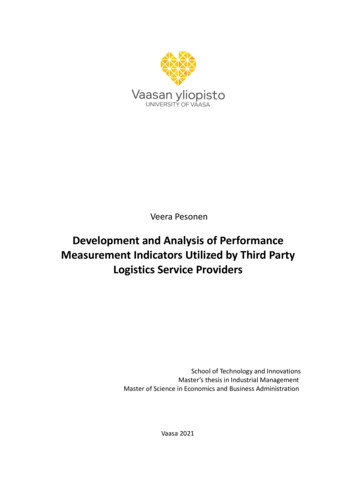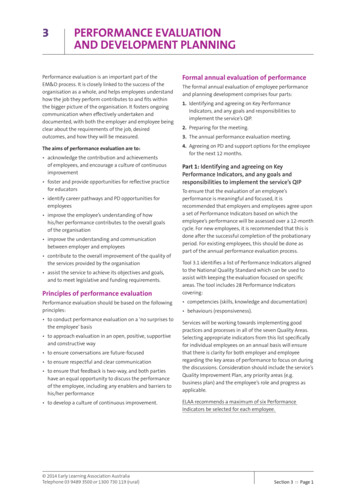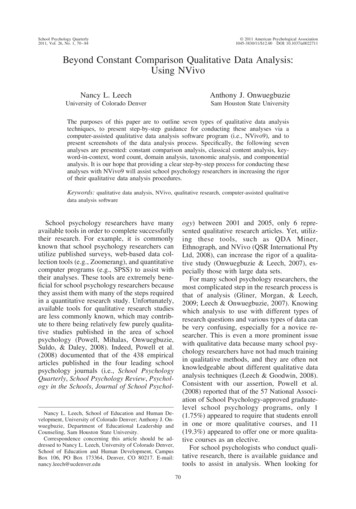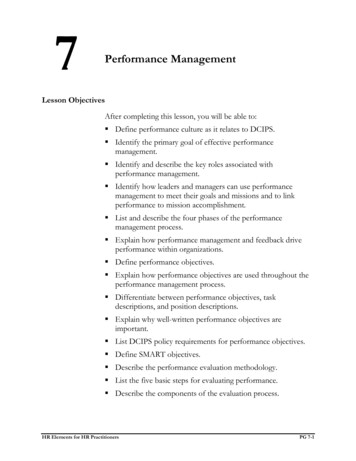
Transcription
Veera PesonenDevelopment and Analysis of PerformanceMeasurement Indicators Utilized by Third PartyLogistics Service ProvidersSchool of Technology and InnovationsMaster’s thesis in Industrial ManagementMaster of Science in Economics and Business AdministrationVaasa 2021
2UNIVERSITY OF VAASASchool of Technology and InnovationsAuthor:Veera PesonenTitle of the Thesis:Development and Analysis of Performance Measurement Indicators Utilized by Third Party Logistics Service ProvidersDegree:Master of Science in Economics and Business AdministrationProgramme:Industrial ManagementSupervisor:Assistant Professor Emmanuel NdzibahYear:2021 Pages: 81ABSTRACT:Performance is important part of a company’s operations as it describes how well company isfulfilling its goals. Supply chain and logistics connect the product to a consumer from the manufacturer via different actions and actors. Transportation is required from sourcing of raw material through production to the delivering of finished products to end users, as also seen inreverse logistics. This thesis combines these two aspects related to performance and its measurement in third-party logistics transportations.Performance and its measurement have been researched a lot but most of the time researchare related to financial point of view. Environmental performance is usually used to measureperformance in green logistics. Logistics performance together with environmental performance has not been research specially in third-party logistics. The focus in this thesis is to research performance from environmental and logistics point of view and especially have thirdparty logistics service providers as a main research area.Research question of this thesis is: What are the key performance indicators utilized by thirdparty logistics service providers in measurements? The objectives for this research question areto find out what performance indicators and key performance indicators third-party logisticsservice providers use in their transportations environmental and logistics measurements. Inaddition, objectives include to finding out why are these indicators chosen. Last objective is todevelop and propose alternative solutions for performance measurement and indicators.This research is based on qualitative interview with an open-ended questionnaire as the datacollection method. The interview has been built around theoretical framework what has beenformed from central findings of the literature review. Literature review is consisted of threeparts which cover the main topics of the study which are third-party logistics service providers,performance measurement and performance indicators. The interview was conducted withone company, so the sample size is 1 as questions were answered from a company-wideperspective.The results showed that the significance of company goals is major in performancemeasurement and indicators as company goals guides indicators selection. Instead importanceof performance measurement system in indicators selection can be stated to be quite minor.Results also pointed out environmental performance to be highlighted in performancemeasurement and especially in performance indicators.Keywords: third-party logistics, performance measurement, performance indicators
3VAASAN YLIOPISTOTeknologian ja innovaatiojohtamisen yksikköTekijä:Veera PesonenTutkielman nimi:Kolmannen osapuolen logistiikkapalvelujen tarjoajien käyttämien suorituskyvyn indikaattoreiden kehittäminen ja analysointiTutkinto:Kauppatieteiden maisteriOppiaine:TuotantotalousTyön ohjaaja:Apulaisprofessori Emmanuel NdzibahValmistumisvuosi:2021 Sivumäärä: 81TIIVISTELMÄ:Suorituskyky on tärkeä osa yritysten toimintaa, sillä se kuvaa kykyä suoriutua tavoitteiden toteuttamisessa. Toimitusketju ja logistiikka yhdistävät tuotteen valmistajalta kuluttajalle eri toimijoiden ja toimintojen avulla. Kuljetuksilla on avainrooli toimitusketjussa ja logistiikassa silläkuljetuksia tarvitaan useisiin eri toimintoihin tuotannon alusta aina tuotteen toimittamiseenloppuasiakkaalle kuin myös paluulogistiikkaan. Tämä tutkimus yhdistää nämä kaksi aspektia jatutkii tekijöitä, jotka liittyvät suorituskykyyn ja sen mittaamiseen kolmannen osapuolen logistiikan kuljetuksissa.Suorituskykyä ja sen mittaamista on tutkittu paljon, mutta useimmiten tutkimukset ovat olleettalouden näkökulmasta. Ympäristön suorituskyvyn mittaukset ovat yleensä kohdistuneet vihreään logistiikkaan. Logistista suorituskykyä yhdessä ympäristön suorituskyvyn kanssa ei ole tutkittu erityisesti kolmannen osapuolen logistiikassa. Tämän vuoksi tutkimuksen pääpaino onsuorituskyvyn mittaaminen erityisesti ympäristön ja logistiikan näkökulmasta ja keskittyen erityisesti kolmannen osapuolen logistiikan palveluntarjoajiin.Tämän tutkimuksen tutkimuskysymys on: Mitkä ovat tärkeimmät suorituskykyindikaattorit,joita kolmannen osapuolen logistiikkapalvelujen tarjoajat käyttävät mittauksissa? Kysymyksentavoitteena on saada selville mitä ympäristön ja logistiikan suorituskyvyn indikaattoreita kolmannen osapuolen logistiikkapalvelujen tarjoajat käyttävät ja mitkä niistä ovat avainindikaattoreita. Lisäksi tavoitteena on selvittää, miksi nämä indikaattorit on valittu sekä tehdä kehitysehdotuksia suorituskyvyn mittaamiseen ja indikaattoreihin.Tämä tutkimus on laadullinen tutkimus, jossa datankeräysmetodina on avoimia kysymyksiäsisältävä haastattelu. Haastattelu on rakennettu teoreettisen viitekehyksen ympärille, joka taason muodostettu kirjallisuuskatsauksen keskeisimmistä löydöksistä. Kirjallisuuskatsaus koostuukolmesta osasta, jotka kattavat tutkimuksen pääaiheet. Nämä osat ovat kolmannen osapuolenlogistiikan palveluntarjoajat, suorituskyvyn mittaaminen ja suorituskyvyn indikaattorit.Haastattelu toteutettiin yhden yrityksen kanssa ja kysymyksiin vastasi yksi työntekijä kokoyrityksen näkökulmasta, joten tutkimuksen otoskoko on 1.Tutkimuksen tulokset osoittavat, että yrityksen tavoitteiden merkitys on suuri suorituskyvynmittaamisessa ja indikaattoreissa, sillä nämä tavoitteet ohjaavat indikaattoreiden valintaa. Sensijaan suorituskyvyn mittausjärjestelmien merkitys indikaattoreiden valinnassa jäi hieman epäselväksi. Lisäksi tulokset osoittivat ympäristön suorituskyvyn korostuvan suorituskyvyn mittaamisessa logistiseen suorituskykyyn nähden.Avainsanat: kolmannen osapuolen logistiikka, suorituskyvyn mittaaminen, suorituskyvynindikaattorit
4Contents1Introduction1.1Background and purpose81.2Research gap, question, and objectives91.3Definitions and limitations3101.3.1 Third-party logistics101.3.2 Performance measurement111.3.3 Performance indicators111.428Structure of the thesisOverview of transportation sector12142.1Transportation challenges152.2Transportation modes16Literature review3.1Third-party logistics service providers20203.1.1 Environmental goals213.1.2 Logistics goals233.2Performance measurement243.2.1 Environmental performance measurement systems and frameworks253.2.2 Developing Environmental performance measurement system273.2.3 Logistics performance measurement systems and frameworks303.2.4 Performance analysis333.3Performance indicators343.3.1 Indicators’ selection and significance for company343.3.2 Environmental performance indicators353.3.3 Logistics performance indicators363.4Theoretical framework383.4.1 Challenges of performance measurement and performance indicators 3843.4.2 Selection of indicators403.4.3 Analysis and development of indicators41Research methodology43
5564.1Data Collection474.2Data Analysis48Results and analysis495.1Analysis about company’s goals515.2Analysis about performance measurement systems545.3Analysis about performance indicators555.4Analysis about KPIs605.5Analysis about indicators overall625.6Discussion about possible development ideas635.7Reliability and validity of the study655.7.1 Reliability655.7.2 Validity66Summary and conclusion696.1Summary of the research696.2Managerial Implications726.3Future research suggestions73References75Appendices81Appendix 1. Interview questions for environmental and logistics performance81
6FiguresFigure 1 Structure of the thesis13Figure 2 Supply chain with transportation and information flow (adapted from Tseng etal. 2005).14Figure 3 Characteristics of different mode of transportation (adapted from Fulzele,Shankar Choudhary, 2019).18Figure 4 Greenhouse gas emissions in Finland by sector and greenhouse gas emissionsdistribution in Finland at energy sector.21Figure 5 Key design principles for creating an EPMS framework.29Figure 6 Research onion (adapted from Saunders et al., 2007, p. 102)44Figure 7 Research process of the study.46Figure 8 PIs and KPIs used by the case company.58TablesTable 1 Performance indicators37Table 2 Answers from the interview50Table 3 KPIs and goals they are related to.61Abbreviations3plThird-party logistics3plspThird-party logistics service providersCSRCorporate Social ResponsibilityEPMEnvironmental Performance MeasurementEPMSEnvironmental performance measurement systemESLEnvironmentally sustainable logisticsESLPMEnvironmentally sustainable logistics performance managementKPIKey performance indicatorLPILogistics performance indicatorLSSLean Six Sigma
7PIPerformance indicatorPMSPerformance measurement systemSCORSupply Chain Operation ReferencesUNUnited Nations
81 IntroductionThis chapter shortly introduce main aspects of this thesis. In chapter 1.1. the background for thesis topic and purpose of this thesis are presented. Chapter 1.2. coversthe identified research gap and thesis research question and its objectives. Chapter 1.3include keywords definitions and tells how the keywords are limited in this research.Thesis structure and short descriptions of every chapter of this thesis are presented inchapter 1.4.1.1 Background and purposePerformance is important for companies to succeed. It is an integral part of a companies’ operations as it describes the how well company is fulfilling its goals (Domingues,Reis & Macário, 2015). Thesis subject is selected based on interests but also for successful factors for business environment. Performance is reflected from effectivenessof actions and systems. Logistics and supply chain are also important parts for companyas they connect the product to a customer via different actions and actors. This thesiscombines these two aspects related to performance and its measurement in thirdparty logistics.The aim of this research is to provide third-party logistics service providers (3plsp) ageneral guideline how to select their performance measurement indicators in an efficient way. By improving these indicators companies can achieve more accurate datafrom its action and company success. This will help them to improve their performance.Purpose of this thesis is to study performance measurement indicators and their selection from different point of views and recognize key concepts for indicators selection.Thesis will provide information about environmental and logistics performance measurement in third-party logistics (3pl) transportation activities. The purpose is to provideuseful information on the selection of performance measurement indicators and thefactors that has an effect to these indicators.
91.2 Research gap, question, and objectivesPerformance and its measurement have been researched a lot but most of the timeresearch are related to financial point of view. Environmental performance is usuallyused to measure performance in green logistics. Logistics performance together withenvironmental performance has not been research specially in third-party logistics.That is why the focus in this thesis is to research performance from environmental andlogistics point of view and especially have third-party logistics service providers as amain research area. Environmental and logistics performance together may also support and provide information to each other and thus are also good combination tostudy.This thesis focusses on transportation as very often 3pl actions are considered as a onebig wholeness so previous research has focused on that. Transportation includes manydifferent sub-areas and modes but, in this thesis, transportation is handled as a wholeand received results work as a common guideline. Even though research related to logistics performance and environmental performance are available, have most of theresearch left out one of the most important things – How to be better? Developmentand analysis to find out how to perform better and choose more efficient indicatorshave been left out from previous studies. Based on this information one detailed research question and three objectives for that question are created for the research:RQ: What are the key performance indicators (KPI) utilized by third-party logisticsservice providers in measurements?a) What performance indicators (PI) and key performance indicators third-partylogistics service providers use in their transportation’s environmental measurements and logistics measurements?b) Why are these indicators chosen? Analyse the effectiveness and efficiency ofsuch performance indicators.
10c) Develop and propose alternative solutions for performance measurement andindicators.Hypotheses for this research are also created. First hypothesis for this research is thatperformance indicators selection is based on company’s goals. Second hypothesis isthat more value is given on environmental indicators than logistics indicators. Thirdhypothesis is that performance indicators are strongly guided by performance measurement system or frameworks.1.3 Definitions and limitations1.3.1 Third-party logisticsAccording to Domingues et al. (2015) logistics is important part of supply chain whichensure to get the right product into right place. Logistics is mainly linked into production sector, but it has remarkable role in other areas like in retailers’ sector. It consistsmultiple actors and multiple activities including transport, warehousing, and customerservice for example. Third-party logistics is one of the main actors of logistics. Jazairy,Lenhardt and von Haartman (2017) tell 3pl to be an actor to whom other companieshave outsourced their logistics activities which are usually related to warehousing, distribution, and transportation.In this research focus is on third-party logistics service providers (3pl). As activities offered by these providers are broad, only transportation activities are considered in thisresearch. Transportation modes are not limited whereas research focus on handlingtransportations overall. However, short introduction and main aspects of transportation modes are told in second chapter.
111.3.2 Performance measurementPerformance measurement is strongly related to performance management. Performance management is overall management of different parts of performance like setting goals and monitor these goals (U. S. Department of Health and Human ServicesHealth Resources and Services Administration, 2011). Domingues et al. (2015) stateperformance measurement to be a tool for company to get information about its actions successfulness and to know if it is fulfilling its objectives and reaching goals. Performance should be measured to avoid failures and to improve efficiency according toJazairy et al. (2017). Performance can be measured both from financial and nonfinancial perspectives. Can be identified for example logistics performance, environmental performance, social performance, financial performance, and customer performance (Kucukaltan, Irani & Aktas, 2016).Wudhikarn, Chakpitak and Neubert (2018) state logistics performance to describe efficiency of logistics activities. These logistics performance measures help companies toimprove its logistics activities. Environmental performance measures assist companiesto monitor their waste and emissions and thus receive important information aboutthe sustainability of the companies’ operations Tung, Baird and Schoch (2018) stated.In this research the focus is on environmental performance and logistics performance.In this research transportation performance is measured from environmental and logistics view. Logistics performance in this case refers all the operational matters of transportations.1.3.3 Performance indicatorsDomingues et al. (2015) and Kucukaltan et al. (2016) tell performance indicators to bepart of performance measurements. Companies base their performance measurementin these indicators and thus pursue to comprehensive measure. As performance indicators are base to performance measurement there are also indicators in several differ-
12ent areas. Khan, Jian, Zhang, Golpîra, Kumar and Sharif (2018) point that environmentalperformance indicators are mostly related to different wastes and emissions. Also, environmental sustainability and usage of different energies are usually considered. Inaddition, Kucukaltan et al. (2016) highlight that environmental performance indicatorscan also be related to people like environmental education, environmental awareness,and satisfaction. For logistics performance indicators Rezaei, van Roekel and Tavasszy(2018) express five core components: customs, infrastructure, services, timeliness andtracking and tracing international shipments. All these components include differentindicators which measure that component.This research will focus on logistics performance indicators which give data abouttransportation. These indicators are strongly related to infrastructure, services, andtimeliness components. In environmental performance indicators the focus is on indicators which will provide data related to waste and emissions as they are strongly related to transportation. Also, other indicators from environmental side will be used ifthey are seen to have impact on transportation.1.4 Structure of the thesisThis thesis consists of six chapters. In figure 1 structure and progress of the research ispresented more clearly but focusing on main aspects. Introduction and background arepresented first and then research gap, question, objectives, and limitations for the research are told. These are all included in first chapter which is an introduction chapterwhere thesis topic, purpose, are presented and relevant concepts defined. Secondchapter is an overview of transportation sector where different transportation modesare presented, and challenges related to transportation handled. Third chapter is literature review which consist of presenting relevant theories of third-party logistics, performance measurement and performance indicators. Theoretical framework is included at the end of the literature review and consist of creating theoretical frameworkbased on literature review. Fourth chapter is about methodology where research
13method and research process are clearly presented. Research method presenting includes that data collection method and data analysis method are told. Fifth chapter isresults and analysis chapter which contains results and discussion part based on theinterview of case company. Last chapter is a summary and conclusion where wholethesis is shortly summarized, drawn conclusions presented and future suggestionsstated.Figure 1 Structure of the thesis
142 Overview of transportation sectorThis chapter present a deeper overview to transportation including different transportation modes and challenges what 3plsp may face. Transportation has key role in logistics and supply chain according to Tseng, Yue, and Taylor (2005). Transportation isneeded in many different procedures from the start of production to the delivery tofinal customer. However reverse logistics also plays main role in transportations. Reverse logistics is logistics where product leaves from consumer and end up to producer.Term reverse logistics is used in touch with recycling as with reverse logistics can makesure that product is disposed correctly. In Figure 2 the role of transportation in supplychain is described.Figure 2 Supply chain with transportation and information flow (adapted from Tseng et al.2005).In normal logistics the chain is starting from supplier and moving to manufacturer thento distributor from where it goes to retailer and ending up to consumer. In reverse lo-
15gistics chain start from consumer and go backwards the normal logistics route endingup in supplier. In addition, this figure shows the information flow between differentprocedures and can be seen that information is moving between every part of the supply chain. From supplier to distributor, from consumer to manufacturer, from retailer toconsumer and so on.Transportation is a link between different parts of supply chain which connects theseparts into one smooth chain tells Tseng, Yue, and Taylor (2005). That is why a lot of cooperation between different operators, like supplier, manufacturer, retailer, and distributor is needed to maximize the outcome. Transportation also has major impact tocustomer and consumer and their experiences. Due to role of transportation, it is important to pay attention at transportation performance. Good transportation performance can have big impact to company’s competitiveness so transportation’s role incompany’s business is remarkable.2.1 Transportation challengesWhen planning transportations and deliveries must be considered financial, logistical,and social matters. Different transportation modes are air, maritime, road, rail, andintermodal. These modes are discussed more closely in chapter 2.2.First need to be considered what freight requires from the transportation according toTripathi, Hudnurkar, and Ambekar (2021). Service price is a key factor considering whatwould be cheapest mode or most cost efficiency mode. What would be the mostreliable transportation mode and what mode would fit best for the situation and forthe freight need to be taken into account. Time related issues are also very importantas when thinking of transportation schedule needs to be considered what is the fastestand what would be the most accurate transportation mode. They also regocnize thecongestion factor which is strongly related to road transportation. Punakivi and Hinkka(2006) presents that for short routes road transportation is usually the best option
16whereas air transportation is used for deliveries where the freight must be deliveredsoonest possible. Kiesmüller, de Kok, and Fransoo (2005) also higlight the importanceon warehousing when selection the appropriate transportation mode. Where thepossible intermediate inventories are located to and what would be the mostreasonable option from that point of view.Kengpol, Tuammee, and Tuominen (2014) identifies in different categories possiblerisks what should be considered when selection the transportation mode. First one isfreight damaged risks which include damaged freight, damaged form transportation,damaged from delivery at warehouse and amaged from delivery to customer. It alsoconsider loss of freight during the transportation. Second risks are infrastructure andequipment risks which refers to capacity of port and railroad traffic and equipmentmaterial handling’s facility. This also includes risk related to tunnels, capacity of bridgesand slope and the width of roads. Also weather conditions like rainy seasons andtropical storms and accident rates are included in this category.Third categorie is political and legislatorial risks which are related directly to laws anddifferent political risks. Traffic rules and customs are also included in this. Fourthcategory includes operational risk which refers to employees skills and differentproblems related to documents like standardization and interpretation. Fifth risksrelates to macro risks like financial crisis, unattractive markets and fierce competition inthe transportation sector. Last category is environmental risks. These risks includeclimate change, toxic waste and appearance of route or building. (Kengpol et al., 2014).2.2 Transportation modesAir freight logistics is used for value of freight is high and need for fast delivery according to Tseng, Yue, and Taylor (2005). Via air freight can be moved fast and with lowerrisk of damage. Air freight is flexible and usually provides a good accessibility and frequency for most common destinations. Air freight disadvantage is high fees of delivery
17but is still more dependable than maritime transportation according to Wood, Barone,Murphy (2002) as it is much unlikely early or late at the departure or arrival place.Maritime is mostly used for international freight as it relatively cheap transportationmode and carrying capacity is high according to Tseng, Yue, and Taylor (2005). Maritime transportation problem is long transportation time compared to air freight whichis also used for international freight. Maritime transportation is also dependent onweather factors. Three different types of operation can be identified in maritime transportation. First one is liner shipping where operation is happening between sameroutes, same price, same ship and regularly happening transportations. Second one istramp shipping which is quite opposite of liner shipping. In this mode route, price andschedule may vary greatly. Third operation mode is industry shipping which aim is toensure the supply of raw materials. In industry shipping also need to take care of possible special needs like high-pressure containers for natural gas.In road freight transportation advantages are its high accessibility, mobility, and availability according to Tseng, Yue, and Taylor (2005). Road freight also has cheaper investment funds. However, road freight has relatively low capacity, slow speed, and lowersafety. Tripathi et al. (2021) tell road transportation main advantage is that booking iseasy compared to other modes and there is available many options for different typesof freights. Road transportation still suffer from many problems like traffic congestionand crashes. Delivery of freight in time is very important part of transportation so traffic congestion is very difficult problem as it takes multiple different steps to avoid thecongestion and reduce the delivery time. Another problem is energy consuming andpollution as road transportation consumes a lot of energy and thus cause a lot of pollution so even though it is very flexible and easily available transportation mode it is notvery sustainable mode.Railway transport carrying capacity is high and it is not influenced by weather as muchas maritime for example according to Tseng, Yue, and Taylor (2005). Railway transpor-
18tation also use a lot of less energy compared to road transportation. Railway transportation has relatively many disadvantages as essential facilities have usually very highcost and maintenance of vehicles and different equipment is difficult and expensive.Railway transport is not very good option for urgent demands as it lacks elasticity as itis very time consuming to organize railway carriages and that is why it is sometimehard to provide transportation frequency as per the customer requirement accordingto Tripathi et al. (2021). They also identify that railway transportation is cheaper optionthan road transportation if there is enough volume for the rail.In addition to use only one transportation mode can be used a multimodal freighttransportation which combines to or more different transportation modes according toKengpol et al. (2014). With multimodal transportation possibilities to transportationroutes and times is broad as different modes can be combined in many ways. In figure3 is presented characteristics of different mode of transportation where can be noticeddifferences between transportation modes more clearly.Figure 3 Characteristics of different mode of transportation (adapted from Fulzele, ShankarChoudhary, 2019).Maritime transportation is located on right which mean that it is slowest and cheapestone and least time-sensitive, but it is not that reliable and visible. With maritime transportation high weights for freight are possible and this transportation mode is usually
19used for freights with lower value. Air transportation is from the other end and locatedon left which means more agile but expensive and highest time-sensitive transportation mode. In air transportation reliability and visibility is much higher. Air transportation freight has lowest weight, but they have usually highest value. Rail and road transportation belong to the middle where rail transportation is left from the maritimetransportation and road transportation right from the air transportation.
203 Literature reviewThis chapter present literature of different sub-areas related to topic. First 3plsp’ environmental and logistical goals are told. Second sub-chapter deals with performancemeasurement and different measurement systems and framework what can be used toperformance measurement in environmental side and in logistics side. Third subchapter is about performance indicators where different indicators for environmentalperformance and logistics performance are presented. Last sub-chapter is theoreticalframework where key concepts of this literature review are linked to each other.3.1 Third-party logistics service providersSetting goals is important because they also influence 3plsp’s other decisions. Isaksson,Hulthén and Forslund (2019) highlight that even though company make its own decisions about goals are these decisions usually guided by customers wishes and requirements. Being close with customer can help 3plsp to understand customer needs andwishes better. This will help company to improve its business process and make it moreefficient. Goals need to be well defined and set for a specific time frame.According to Arababadi, Moslehi, El Asmar, Haavaldsen and Parrish (2017) companyshould have long-term goals, medium-term goals, and short-term goals to increase thesuccess of company business. Long-term goals are for strategic level and are usuallyvery broad goals which may not incl
Transportation is required from sourcing of raw ma-terial through production to the delivering of finished products to end users, as also seen in . What are the key performance indicators (KPI) utilized by third-party logistics service providers in measurements? a) What performance indicators (PI) and key performance indicators third-party .











